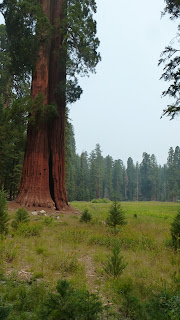Crescent Meadow
This being our first full day in Sequoia National Park, we decided to hike in one of the largest groves of Sequoias. Of the 68 groves of Sequoias, the Giant Grove is the second largest by some measures. It contains 8400 Sequoia of at least one foot in diameter and 5 of the 10 largest. It is also the home of the largest living thing on earth, by volume, the General Sherman Tree. We passed by it about mid day. It is 2100 years old and 275' tall and 100' wide at the trunk.
36 paces around
Sequoias occur only in the Sierra Nevada Mountains of California between 4500' and 7600' in elevation. It is not known if they have an age at which they decline. The oldest trees are 3000 years old and have survived the mini ice age, numerous fires and eras of wetness and dryness. Their most common death is from toppling. Once a tree begins to lean in one direction, it grows its base to compensate but in many cases, the weight of the tree can't be held up by the shallow root system and it falls over. In 1964 a ranger witnessed a Sequoia falling. First, he heard roots popping and then a tremendous thunder as the tree came down. He said water gushed from the the tree and it was ice cold to the touch. In September 2011, twin 1500 year old Sequoias fell with a few seconds of the event caught on camera by a German tourist. That fall can be viewed on You Tube.

The trees go through several phases. Seedlings are started when fire opens the pine comes and disperses seeds. Since a fire has occurred, the seedlings are able to grow without much competition. Fires occur, on average, every 13 years. So, some seedlings don't survive but some do. Once they have become established, they too, can survive fire. For 700 to 800 years, the tree groves in height reaching a height which insures access to sunlight. During this growing phase, the tree takes on a spire shape. Once it has attained its height, it is considered a mature tree and begins to grow only in width. The final phase is when a mature tree attains a size which dominates all around it; its Monarch stage.
Tharp's Log House
A shepherd lived in a hollow log fashioned into a cabin of sorts. The bark of tree has so much tannin in it, rotting can take centuries.

When I first heard the bark of a Sequoia could be 30 inches thick, I could not believe it. After seeing several of these trees and the logs, it is much more believable. If you rap on a tree, it has a slightly hollow feel to it. There is an air pocket between the bark and the sapwood. If a fire could ever burn through the bark, it would have this air pocket and a very moist sapwood to deal with. Hence, very few large Sequoias succumb to fire. They actually benefit from it. Fire destroys other trees which compete for sunlight with Sequoias. Fire opens the pine cones. We saw evidence of fire on almost every tree. Much of it was intentionally started. The Giant Grove was a huge tourist attraction from the beginning of the park. Cabins, roads, buildings, stores, restaurants, gas stations etc were built among the giant trees. Fire suppression was practiced to protect these assets. Once it was determined the infrastructure was detrimental, removal took place. Once the forest was relatively clear, a very carefully planned prescribed burn was done to remove about 100 years worth of fuel. Since fires occurred naturally much more frequently, it was of concern more fuel might actually damage the trees.

One of the first things I learned and was surprised to hear; this was the second national park, established in 1890. Logging of Sequoia began in the 1880s. Even at this time, some of the individual trees had names. At first, the general public did not believe trees of this size existed. Efforts to prove their size were called hoaxes. Eventually, it was outrage of locals which resulted in protection. Still, not all trees were protected and logging continued until about 1907. the wood had low quality uses, like shingles, grapevine stakes etc. Often the brittle wood would splinter when felled
Despite having taken a photo of the trail map at the trailhead, we still were never sure where we were. Junctions had confusing signage and dead end trails to trees kept us guessing which way to go. The area we walked through had a few meadows. These looked like isolated wet areas where no trees grew. Wetness damages Sequoia roots and can cause the tree to topple.
Finally we made our way to a paved walk, the Congress Trail loop. Many of the trees here were named and quite large. The "family" below was named "The House" for the House of Representatives.
The House
Congress Trail
The Congress Trail loop is off the General Sherman trail. General Sherman Tree is the largest living thing, by volume, in the world. After viewing it from a distance, we hiked up to a shuttle bus stop, not realizing we could have walked down to another and in the process, pass right by the big tree. Our plan had been to park on a side road off the Generals Highway and hike to a shuttle stop, hop on the bus and ride back to our parked car. We did make one stop on the shuttle, stopping at the Visitors Center and Museum. Formerly, this building was a general store among a small village of tourist cabins. From here we walked around Round Meadow and encountered 4 Black bears; 3 blondes and a black.
"Blonde" Black Bears
Twins: Ned & Ed
Separate trees which grow together are called twins. Here at the edge of the meadow are Ned and Ed.
Round Meadow area













































